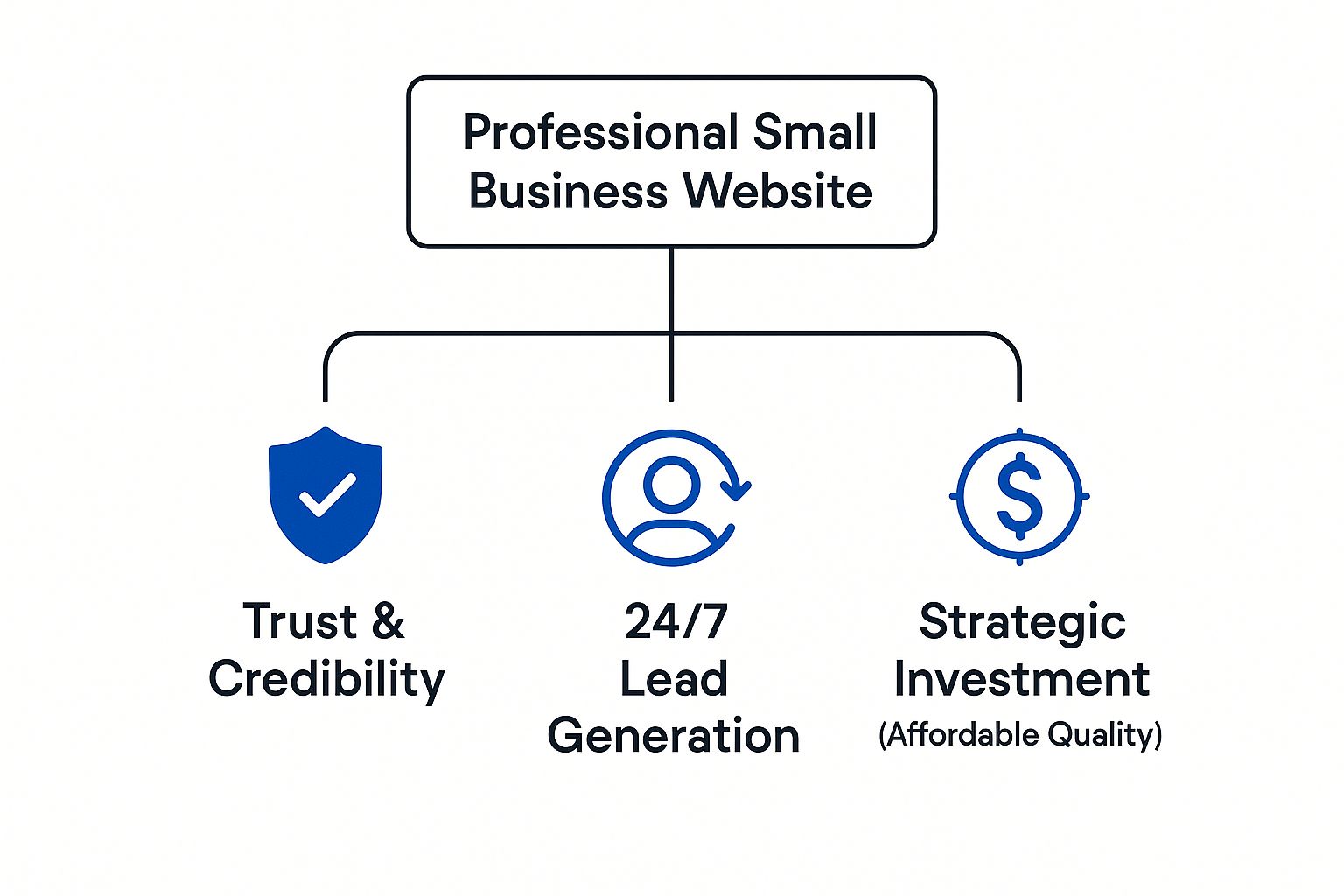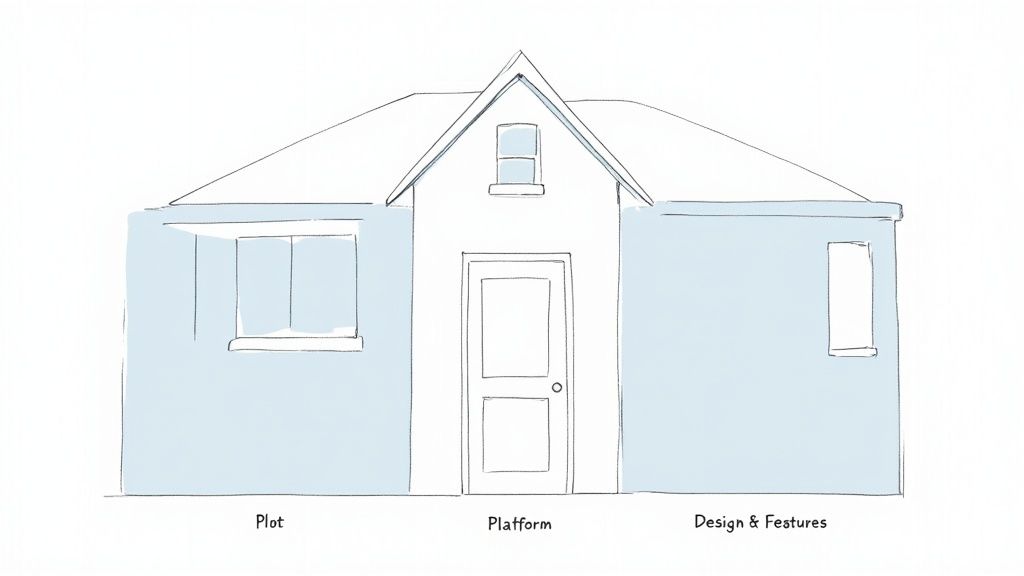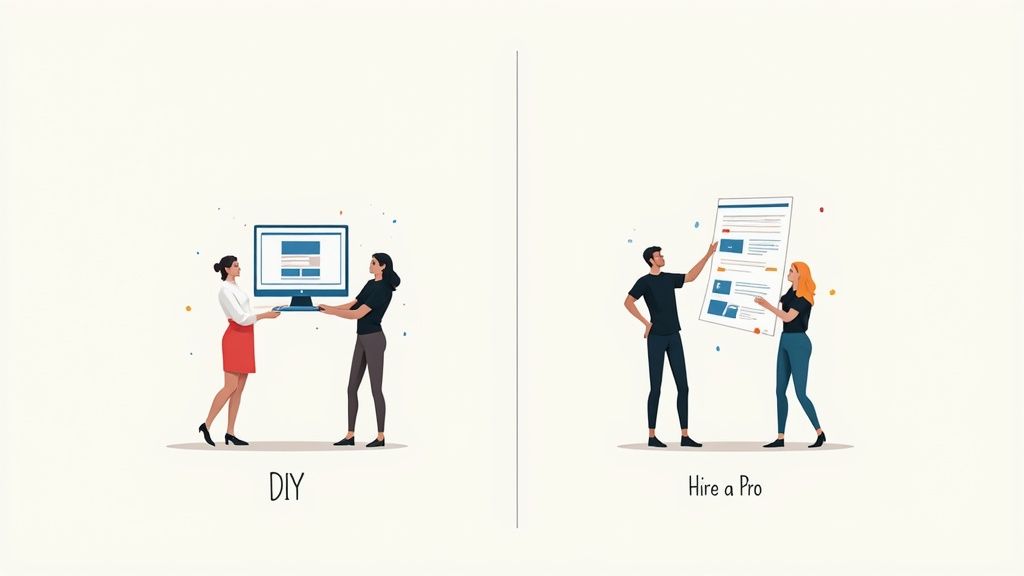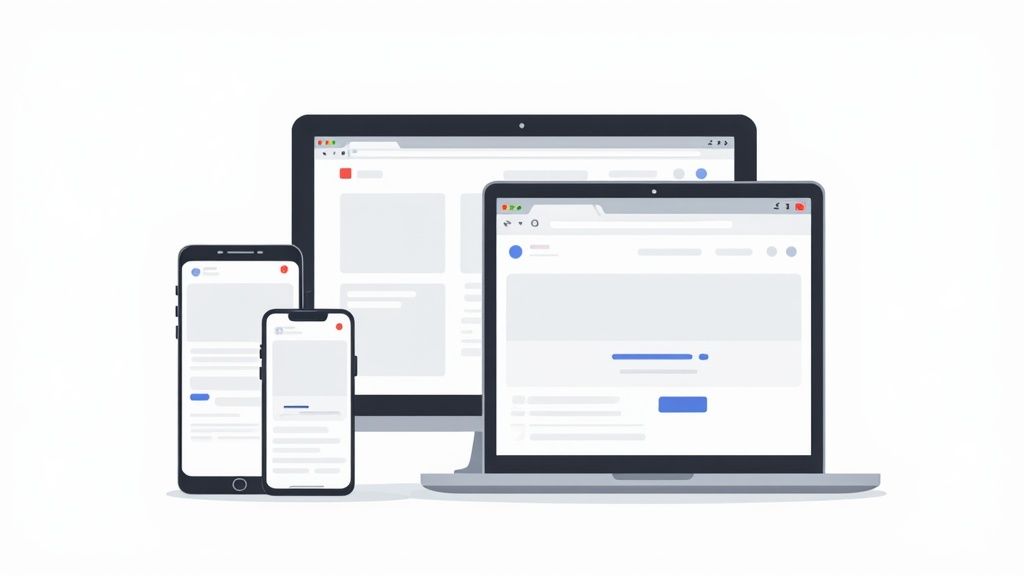
Getting an affordable small business website design isn’t about chasing the cheapest price tag. It’s about making a smart investment. For any UK business, your website is your single most powerful tool for building trust and pulling in leads around the clock. This guide is here to prove that you don’t have to choose between quality and affordability.
Why a Great Website Is Not a Luxury
Let’s get one thing straight: you don’t just ‘need a website.’ That thinking is outdated. Your site is your digital shopfront, your hardest-working salesperson, and the very foundation of your brand’s credibility. For most people, it's the first time they'll ever interact with your business, and that first impression is everything.
A well-built website does more than just sit there looking pretty; it actively works for you. It builds trust through a professional look, guides visitors towards making a purchase or getting in touch, and consistently shows off what your brand is all about. When you think of it that way, the cost stops being an expense and becomes a core business investment.
This infographic breaks down exactly what a professional website delivers for a small business.

As you can see, the benefits go way beyond just looking good, branching out into lead generation, trust, and the long-term strategic value of a well-designed site.
The True Cost of a Poor Online Presence
Cutting corners might feel like a savvy move at first, but a poorly made website will cost you far more in the long run through lost sales and missed opportunities. The numbers don't lie. In fact, over 92% of small businesses in the UK say a website is critical to their success. What’s more, sites that are properly built can generate up to 68% more leads, which shows the direct return you get from investing in effective design. You can explore more web design statistics to see the full picture.
A cheap website saves you money once. A strategic, affordable website makes you money for years. It's not about the initial price tag; it's about the long-term value it creates for your business.
Ultimately, this guide is about helping you make smart choices. We’ll walk you through how to navigate the different platforms, features, and design decisions to create a professional, effective website—without the eye-watering agency price tag. Affordability and quality aren't mutually exclusive; they're the keys to your digital success.
Understanding Your Real Website Costs
Trying to get a straight answer on what a website really costs can feel like trying to nail jelly to a wall. It’s a common frustration. The simplest way to think about it is like building a house: you’ve got the initial cost to buy the land and lay the foundations, and then you’ve got the ongoing bills and upkeep to keep it running.
Let's break that down. Your domain name (e.g., yourbusiness.co.uk) is your street address, and hosting is the plot of land your website lives on. Those are your first essential purchases. The platform you choose, like WordPress or Squarespace, acts as the foundation – it’s what everything else is built on. The actual design and features? That’s the architecture and interior decorating that makes the house a home for your customers.

This structure helps you separate the one-off setup fees from the recurring maintenance costs, giving you a much clearer view of where your money is actually going.
Initial Setup vs Ongoing Maintenance
The single biggest mistake small businesses make is focusing only on the upfront price tag. A genuinely affordable small business website design isn't about the cheapest initial quote; it's about balancing both the setup and long-term costs effectively.
Your initial investment covers all the creative and technical graft needed to get your site designed, built, and launched. This is usually the largest single payment you’ll make.
- Design and Development: This is the visual layout, the user experience, and all the code that brings your site to life.
- Content Creation: It involves writing the text for your core pages and sourcing the right images or graphics.
- Initial SEO Setup: This means implementing the foundational search engine optimisation to help Google find and understand your new site.
But once your website is live, the costs don't just stop. Ongoing maintenance is absolutely crucial for security, performance, and keeping your site relevant. These are typically smaller, recurring payments.
- Hosting and Domain Renewal: These are the annual fees you pay to keep your site online and your web address registered to you.
- Security Monitoring: This is about protecting your site from hackers, malware, and other nasty threats.
- Software Updates: It involves keeping your website’s platform and any plugins up-to-date to prevent bugs and security holes.
- Content Updates: This could be anything from adding new blog posts and changing service information to updating staff photos.
Understanding this division is key. A cheap initial build might look tempting, but it can easily lock you into expensive or difficult maintenance, costing you a lot more in the long run. For a clearer picture, check out our detailed guide on the small business website cost in the UK.
What to Expect for UK Businesses
Let's talk numbers. This table gives you a rough idea of the initial and ongoing costs you can expect, depending on which route you take.
Typical Website Cost Breakdown for UK Small Businesses
| Expense Type | DIY Website Builder | Template-Based Site (e.g., WordPress) | Custom Design Agency |
|---|---|---|---|
| Initial Setup Cost | £0 - £250 (Mainly for premium templates or plugins) | £500 - £2,500 (For a developer to set up and customise a template) | £3,000 - £10,000+ (For a fully bespoke design and build) |
| Annual Running Costs | £120 - £400 (Monthly subscription fees) | £150 - £600 (Hosting, domain, premium plugin renewals) | £500 - £2,000+ (Hosting, security, support retainers) |
As you can see, the costs vary wildly based on how much work you do yourself versus how much you hand over to a professional. A basic DIY site on a platform like Squarespace can cost as little as £40 to £80 per month. But if you need something more customised that actually helps you stand out, a professional build will typically start from £1,500 and can go over £7,000, with ongoing maintenance averaging around £1,000 to £1,200 annually. You can find more insights in these small business website statistics.
Reading a quote is about more than just the final number. It’s about understanding the value packed into that price—from hosting security and platform updates to ongoing support.
By knowing what to look for, you can spot hidden fees and properly assess the value of any proposal, whether you choose a DIY builder or hire a professional to handle everything for you.
Choosing Your Path: DIY Builders vs Hiring a Pro

This is one of the biggest forks in the road you'll face. Should you roll up your sleeves with a Do-It-Yourself (DIY) platform, or is it smarter to bring in a professional to do the heavy lifting? This isn’t just a simple pros-and-cons list; it's about honestly matching your time, skills, and business goals with the right approach.
Let's walk through what each path really looks like, so you can make a choice that gets you a genuinely affordable small business website design without cutting corners on quality.
The Do-It-Yourself Route
DIY website builders like Wix, Squarespace, and Shopify have thrown the doors open for anyone to have a go at creating a website. With drag-and-drop tools and ready-made templates, they can feel like a great starting point, and they're almost always the cheapest option upfront.
This path is a brilliant fit for a certain type of business owner. If you have a crystal-clear vision, a decent eye for design, and—this is the big one—the time to actually learn the platform and build the thing yourself, you can get a great result. It works best for businesses that don't need complicated features, like a simple portfolio, a basic brochure site for a service, or a very small online shop.
But there are definitely pitfalls. What you save in cash, you pay for in time. Building a site that looks polished and professional can easily soak up dozens of hours. More importantly, many DIY platforms have hidden limitations that can cramp your style later on, especially when it comes to search engine optimisation (SEO). They’ve got a lot better, but getting the advanced SEO right is often a lot harder than on a platform like WordPress.
Think of a DIY builder like flat-pack furniture. It's affordable and it does the job, but you're the one who has to assemble it. Follow the instructions perfectly, and you'll get a solid result. Miss a step, and the whole thing might end up a bit wobbly.
Hiring a Professional Freelancer or Agency
Bringing in an expert—whether it's a freelance developer or a small design agency—completely changes the game. Instead of spending your own valuable time trying to learn a new skill from scratch, you're paying for their expertise, their efficiency, and a bespoke website that's built specifically for your business.
This is the path for business owners who know they need a high-performance site but just don't have the time or the technical know-how to build it themselves.
A professional build brings some serious advantages to the table:
- Customisation: A developer isn't stuck inside a template. They can build a unique design that perfectly captures your brand's personality and feel.
- Performance and SEO: Professionals build sites with clean code, fast loading speeds, and a rock-solid SEO foundation from day one. It gives you a real competitive edge.
- Scalability: A custom-built site is made to grow with you. Need to add a complex booking system or a members-only area down the line? No problem.
The main hurdle, of course, is the cost. While hiring a professional is a bigger investment at the start, it can deliver a much higher return through better performance, more leads, and a far superior experience for your customers.
Vetting Your Potential Partner
If you decide the professional route is the one for you, finding the right partner is absolutely key. Don't just jump at the cheapest quote you get. Here’s how to properly vet a freelancer or agency:
- Review Their Portfolio: Take a good look at their past work. Do their projects look professional? Is the quality what you're looking for?
- Check Testimonials: What are their past clients saying? Look for comments on their communication, sticking to deadlines, and the final outcome.
- Ask Key Questions: Get them to walk you through their process. Find out exactly what's included in their packages (like hosting and ongoing maintenance) and how they manage the project.
- Discuss SEO: A good web designer will bring up SEO in the very first conversation. Ask them how they make sure their sites are built to be found on Google.
Ultimately, choosing between DIY and a professional comes down to an honest look at your own time, skills, and budget. By understanding what each path truly demands, you can pick the one that sets your business up for success in the long run.
Essential Features Your Website Cannot Live Without

When every pound counts, it's easy to get distracted by flashy website features that don't deliver results. But a truly affordable small business website design isn't about cutting corners; it's about focusing your budget on the essentials that actually drive growth.
Think of these core features as the engine, wheels, and steering of your car—without them, you're not going anywhere. These are the non-negotiables that work together to attract visitors, earn their trust, and guide them towards becoming a customer.
Mobile-First Responsive Design
These days, more people browse the internet on their phones than on desktops. That’s not a trend; it's the reality. A mobile-first approach means your website is designed primarily for the small screen and then adapted for larger ones, not the other way around.
This isn't just a "nice-to-have" anymore. Google prioritises mobile-friendly sites in its search results, so a clunky mobile experience can make you practically invisible to potential customers. For a deeper dive, you can learn more about https://altitudedesign.co.uk/blog/what-is-responsive-web-design and why it’s so critical.
Your website must look and function flawlessly on a smartphone. If a user has to pinch and zoom just to read your content, they’ll simply leave and go to a competitor.
Building this way is also kinder to your budget. Focusing on a single responsive design that works everywhere is far more cost-effective than building and maintaining separate sites for desktop and mobile.
Clear Navigation and Calls to Action
Imagine walking into a shop with no signs or labels on the aisles. You wouldn't know where to find anything, and you'd probably just walk straight out. Your website's navigation is the signage for your digital shopfront—it has to be simple, logical, and completely intuitive.
Just as important are your Calls-to-Action (CTAs). These are the buttons and links that tell visitors what to do next, like "Get a Quote," "Shop Now," or "Contact Us." Every single page on your site should have a clear purpose and a CTA that moves the user one step closer to becoming a customer.
Foundational On-Page SEO
Search Engine Optimisation (SEO) is simply the practice of making your site easy for search engines like Google to find and understand. The good news is you don't need a massive budget to get the basics right.
Foundational on-page SEO includes things like:
- Keyword-rich page titles and descriptions: These tell Google what each page is about in its own language.
- Clean URL structures: Simple, readable web addresses help both users and search engines.
- Fast loading speeds: A slow site is a massive turn-off for visitors and a big negative ranking factor.
- Image alt text: Writing descriptions for your images helps with accessibility and search visibility.
And it doesn't stop with traditional SEO. Making your site discoverable by AI chatbots and voice assistants through techniques like answer engine optimization is quickly becoming essential to future-proof your online presence.
Nearly 80% of business-to-business buyers check out company websites before making a decision. With 84% of visitors doing that on mobile, a clean, fast, and optimised design is paramount to capturing their interest.
How to Make a Template Look Like You Paid Thousands
Let's be honest, website templates are the secret weapon for getting a brilliant small business website without a massive price tag. They give you a professional, well-built foundation to work from, saving you from the eye-watering cost of starting a design from absolute scratch. But the real skill is taking that template and making it feel completely, uniquely yours.
Think of a good template like a well-built show home. The structure is solid, the layout makes sense, and all the important bits are in the right place. Your job is to come in and make it a home—choosing the paint, hanging your own pictures, and arranging the furniture so it feels like your space, not a generic display.
The biggest mistake people make is just dropping their text and logo into the default layout and calling it a day. A few smart, strategic customisations are all it takes to transform a template from an obvious off-the-shelf design into something that looks and feels genuinely bespoke.
Start with a Solid Foundation
Before you can even think about personalising, you have to start with a high-quality template. A cheap or badly coded theme will only give you headaches later on. Investing a little bit now, often between £40 to £80 for a premium theme, can save you hundreds in developer fees down the line.
When you’re choosing, hunt for these crucial features:
- Properly Mobile Responsive: Don’t just take their word for it. Open the demo on your phone. It has to look and feel perfect on a small screen, because that's where most of your visitors will see it.
- Good Reviews and Real Support: Look for templates with consistently high ratings. Pay attention to comments that mention the developer's support was helpful. This is worth its weight in gold when you get stuck.
- Sensible Customisation Options: The theme should give you easy control over the important stuff like colours, fonts, and basic layout tweaks without needing to touch a single line of code.
Inject Your Brand’s Personality
Once you’ve got your solid template, it's time to make it unmistakably yours. This is where you stamp your brand’s personality into every corner of the site, turning the generic into something specific and memorable. The goal is for someone to land on your site and know instantly where they are.
Your brand is so much more than just a logo. It’s the combination of colours, fonts, and imagery that creates a feeling. A template is just the canvas; your brand identity is the paint you use to create the masterpiece.
Start by rolling out your core brand elements consistently across every single page.
- Your Logo and Colour Palette: Get a high-resolution version of your logo uploaded, then meticulously swap out the template's default colours for your brand's primary and secondary shades. Be thorough.
- Typography: Don't just settle for the default fonts. Choose typefaces that actually match your brand’s personality—whether that’s modern and clean, or traditional and elegant.
- High-Quality, Real Imagery: This is the big one. Ditch all the stock photos and replace them with professional images of your team, your products, or your work in action. Authentic photography is one of the fastest ways to make a site feel completely unique.
Keeping Your Website Affordable Long-Term
Launching your website is a huge milestone, but it's just the start of the journey. A genuinely affordable website strategy looks beyond the initial build, focusing on smart ways to manage ongoing costs and protect your investment for years to come.
Think of it like owning a car. You don't just pay for it once; you budget for fuel, insurance, and routine servicing to keep it on the road. Your website is no different. It needs ongoing attention to stay secure, fast, and effective. A bit of smart planning now will save you from expensive headaches later on.
Plan for Growth and Maintenance
One of the best ways to keep long-term costs in check is to choose the right foundation from day one. Try to anticipate what you'll need in the future. If you think you might add an online shop or a booking system in a year's time, make sure your chosen platform can handle that growth without forcing a complicated and costly migration to a whole new system.
Equally important is getting to grips with basic upkeep. You can handle many simple updates yourself, but it’s crucial to have a plan for the more technical tasks. This is where a solid support partner comes in. It’s well worth understanding what goes into professional website maintenance and support packages and why they are such a sensible investment.
"Your website is a living asset, not a one-time purchase. Investing a small amount in regular maintenance is far cheaper than paying for a major emergency repair or a complete rebuild."
In the United Kingdom, demand for web design surged from 2022 as businesses got serious about their online presence. This shift really highlights how essential accessible and affordable website solutions have become for helping small businesses adapt and grow. You can discover more insights about these web design market dynamics.
Your Questions, Answered
Jumping into the world of web design for a small business can feel like navigating a maze. It’s only natural to have a few questions. Here are some straight-talking answers to the most common queries we hear from UK business owners, designed to help you move forward with confidence.
How Much Should a Small Business Website Cost in the UK?
Honestly, there’s no single price tag. The cost really boils down to how complex your needs are. A simple DIY site using a builder like Squarespace might set you back £120-£400 a year. If you get a professional to build a site using a pre-made template, you’re often looking at £500-£2,500 as an upfront cost. For a completely bespoke, custom-built design, prices generally start from £3,000 and go up from there. Always get clarity on the initial build cost versus any ongoing monthly or annual fees.
Can I Really Build a Good Website Myself?
Absolutely, as long as your needs are pretty straightforward and you have the time to commit. DIY builders are fantastic for simple brochure-style sites or small portfolios because they're so user-friendly.
However, if your site needs specific features, a serious SEO strategy from day one, or a brand presence that’s truly unique, hiring a professional almost always delivers a much better return in the long run.
One of the biggest factors in choosing an affordable web design solution is being honest about your own skills and, crucially, your available time. What you save in pounds, you will almost certainly spend in hours.
What Is the Cheapest Way to Get a Website?
Technically, the cheapest way to start is with a free plan on a DIY website builder. But these usually come with big compromises, like having the platform’s ads on your site and not being able to use your own domain name, which doesn't look very professional.
The most cost-effective method is often using a premium template on a versatile platform like WordPress. This approach strikes a great balance between a low initial cost and the professional quality and scalability you’ll need as your business grows.
Ready for a website that actually delivers results without draining your budget? At Altitude Design, we specialise in creating high-performance, hand-coded websites for small businesses right across Scotland. Get a transparent, fixed-price quote and let’s talk about how we can help your business grow. Start your project with Altitude Design today.